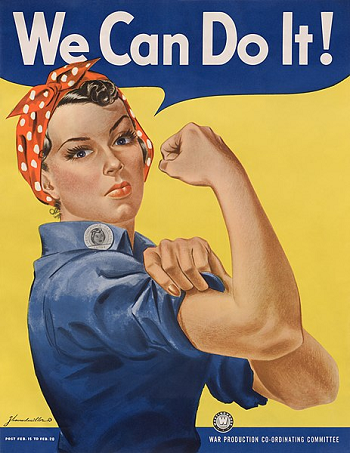Main Content
Lesson 02
L02 Societal Changes Affecting Employment in the US – World War II
You may be familiar with the image to the right, known as “Rosie

Do It! NARA 535413 - Restoration 2, public domain
the Riveter.” Commissioned by the Westinghouse Electric Corporation, J. Howard Miller created what is now considered “one of the most famous icons of World War II”. The story behind this image is that while “the boys” were fighting the war in Europe, Asia, or elsewhere, women were encouraged to work in defense and other traditionally male-dominated industries and occupations in the United States.
Once the war ended, many women went back to the traditional role of homemaker, but others remained employed, particularly in blue-collar jobs (those that require protective clothing, as opposed to “white-collar jobs” which would normally take place in office settings). Later, many women took clerical jobs (those typically handled by a clerk, such as secretaries, receptionists, etc.) instead of blue-collar ones. This may be due to higher education levels brought about once the war ended, though these effects varied, based on how much mobilization occurred in each state (Bellou and Cardia, 2016).
This was a large war mobilization that took place from 1939-1945, where more than 12 million military personnel were deployed during the war, of which less than 359 thousand were women, according to the National WWII Museum. As a result, World War II was a historical event that opened job opportunities not just for women, but for African Americans and similarly underrepresented minorities (URMs, which include Native Americans and Hispanics) as well.
Coordinated actions by Black leaders A. Philip Randolph and Walter White were a contributing force to the enactment of Executive Order 8802 in 1941 (Bracey and Meier, 1991).
This order compelled equal employment opportunities for all U.S. citizens, irrespective of their race, creed, color, or national origin. The result of this order particularly affected defense contractors, which, at the time, had selection and recruitment preferences that resulted in racial segregation and discrimination against workers of color. This Executive Order is also considered an ancestor of the Civil Rights Act.
